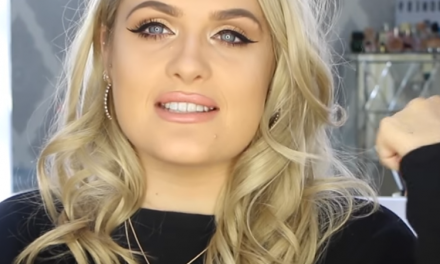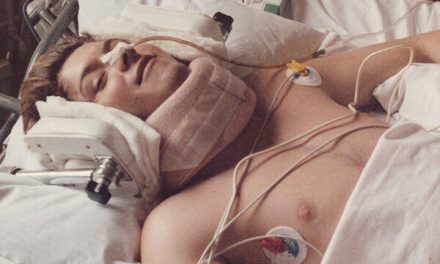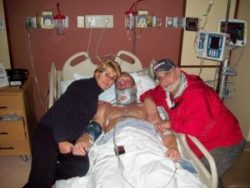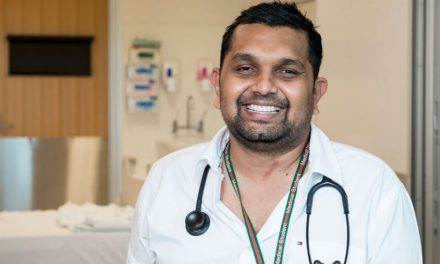Nurse Andrea Dalzell was diagnosed with transverse myelitis at the age of 5.
At 6:45 p.m., on a warm spring evening, Nurse Andrea Dalzell pushes into the Montefiore Medical Center in the Bronx, New York City. COVID-19 cases are surging. Dalzell, a registered nurse, drops off snacks to share in the staff lounge, puts on protective gear, and huddles up with her coworkers around a white dry erase board.
For the next 12-plus hours, Dalzell, who typically has six to eight patients, and up to 13 when the floor is short-staffed, administers medication, tends to wounds, gives baths and suctions the airways of those on vents. She holds patients’ hands when they need comforting, FaceTimes with their family members and responds to codes. The stakes are high and the work is emotionally taxing, but Dalzell is exactly where she wants to be — at the bedside caring for patients.
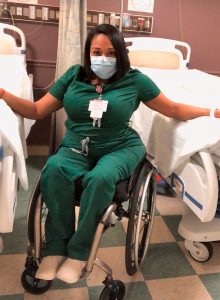 At 33, Dalzell is the only registered nurse she knows of in New York City who uses a wheelchair, and she is forging a path for people with disabilities in healthcare. “Andrea is a pioneer,” says Karen McCulloh, a nurse with multiple disabilities who co-founded the National Organization of Nurses with Disabilities in 2003. “Nursing with a disability is still not completely accepted.”
At 33, Dalzell is the only registered nurse she knows of in New York City who uses a wheelchair, and she is forging a path for people with disabilities in healthcare. “Andrea is a pioneer,” says Karen McCulloh, a nurse with multiple disabilities who co-founded the National Organization of Nurses with Disabilities in 2003. “Nursing with a disability is still not completely accepted.”
Despite repeatedly having her abilities questioned through school and being repeatedly denied acute care nursing jobs, Dalzell answered Governor Andrew Cuomo’s plea for assistance as COVID-19 cases overwhelmed New York City hospitals. “I just wanted to help,” she says. Dalzell’s knowledge of ventilators, gained from having friends who use them, proved valuable, and her co-workers and superiors took notice.
In recognition of her achievements, the Craig H. Neilsen Foundation selected Dalzell as one of the inaugural recipients of its Visionary Prize and awarded her $1 million to use at her discretion. Dalzell is still figuring out how she will use the money, but has already started a foundation to help bridge the gap between education and employment for people with physical disabilities.
We have no doubt that whatever Dalzell does will continue to build on the progress she has made, and we’re excited to see what her future holds. Her tenacity, compassion and vision are exemplary and shape her vocal leadership in a key, often-overlooked field. On the heels of a relentless and trying year, where the importance of public health and the essential nature of health care workers were constantly reinforced, it’s hard to imagine a more ideal person to honor as the 2020 NEW MOBILITY Person of the Year.
Dalzell was born and raised in Brooklyn, New York. She was diagnosed with transverse myelitis, an inflammation of the spinal cord that causes pain, muscle weakness and paralysis, when she was 5 years old. Even at a young age she was a force to be reckoned with. Dalzell laughs recalling a recent conversation with her childhood rehab doctor. “She said, ‘Andrea, you are grown, you are beautiful. I always knew you were going to be someone in the world, because even at 5 you were feisty, you were smart, you knew what you needed and you ran the show,’” says Dalzell. “That is very interesting for me to hear because I run the show now.”
Dalzell attributes her tenacity to her parents, first-generation immigrants from Guyana, who encouraged hard work and perseverance. “I told Andrea, don’t let anyone ever tell you there is something you can’t do,” says her mother, Sharon Dalzell. “Just look at them straight in the face and say, ‘Watch me.’ As long as you do it in the right way, you’ll reap the benefits in the years to come.”
Dalzell was born and raised in Brooklyn, New York. She was diagnosed with transverse myelitis, an inflammation of the spinal cord that causes pain, muscle weakness and paralysis, when she was 5 years old. Even at a young age she was a force to be reckoned with. Dalzell laughs recalling a recent conversation with her childhood rehab doctor. “She said, ‘Andrea, you are grown, you are beautiful. I always knew you were going to be someone in the world, because even at 5 you were feisty, you were smart, you knew what you needed and you ran the show,’” says Dalzell. “That is very interesting for me to hear because I run the show now.”
Dalzell attributes her tenacity to her parents, first-generation immigrants from Guyana, who encouraged hard work and perseverance. “I told Andrea, don’t let anyone ever tell you there is something you can’t do,” says her mother, Sharon Dalzell. “Just look at them straight in the face and say, ‘Watch me.’ As long as you do it in the right way, you’ll reap the benefits in the years to come.”
Finding a Job
After graduation, Dalzell applied for acute care nursing jobs in hopes of building a strong foundation. “Why not have me there when someone is newly injured or dealing with having a stroke or diabetes?” she asks. “They get to see me living my life and taking care of them.” Dalzell had 76 interviews for nursing positions in hospitals and was rejected for all of them.
“The first 10 or so interviews I never brought up my disability, but then I realized something had to give because I was having great interviews,” she says. Dalzell began discussing her disability and how she handles certain situations, like ambulating patients and performing CPR, but that didn’t help.
“There is this very old-fashioned Florence Nightingale view that nurses are pristine in appearance, healthy and well. Though most people with disabilities are healthy, we are constantly being challenged about our abilities,” says McCulloh, who was working in neurosurgery intensive care nursing in the late 1980s when she began experiencing symptoms of multiple sclerosis. “And though there is a gradual movement towards more diversity and inclusion initiatives in healthcare, we are not there yet.”
While trying to secure a position in a hospital, Dalzell worked as the health director at Rising Treetops at Oakhurst, a camp for kids and adults with physical and intellectual disabilities. “I went there as a camper when I was young, and it was great to be back,” she says. “There was this unspoken understanding between me and the campers. Not only do I understand what they are going through medically, but I understand it as a peer.”
Dalzell then moved on to case management, which she hated. “It’s heart wrenching telling people that certain things aren’t covered by insurance or that they don’t qualify for certain services,” she says. “I also don’t like being behind a desk.”
Dalzell was working as a school nurse when the COVID-19 pandemic hit in March 2020, and schools closed throughout the country.
Answering the Plea For Nurses
Quarantining at home in Brooklyn with her parents and two siblings, Dalzell updated her resume and applied for jobs. “I had staffing agencies tell me, ‘We can’t place you. We don’t think anyone’s going to want you,’” she says. “I had two interviews for dialysis positions. The first person claimed he forgot he made the appointment when he saw me, and when the second found out I use a wheelchair, I heard him tell his assistant, ‘In a wheelchair? For an interview? No way. Nurses can’t be in chairs.’”
As the number of COVID-19 cases grew, the door opened for Dalzell. Answering Governor Andrew Cuomo’s plea for nursing help, she filled out an online survey for placement and saw Montefiore Medical Center’s human resources number listed. She called and left a message, assuming she wouldn’t hear back. But 15 minutes later, the phone rang, and she was hired.
Dalzell picked up her credentials and went through a half-day of training without a hitch. But, before the day ended, the director of nursing pulled her off the floor, questioning her abilities. “I asked her if she had spoken to HR, because they hired me,” says Dalzell. “She told me she didn’t mean to be offensive, and I went back to work. After that, they all sang my praises.”
Saskia Hosein, an RN at Montefiore, remembers the first time she saw Dalzell. “We have computers on wheels, and Andrea was pushing her wheelchair as well as the computer,” says Hosein. “I asked her if she needed help, thinking that is the right thing to do.” Though Dalzell declined her help, they immediately connected. “As nondisabled people, we have this image in our mind that people with disabilities can do less, but with Andrea it was the complete opposite,” explains Hosein. “That first night I met her she had an 11-patient load, which is a lot. She was calm, focused and was just getting it done.”
Dalzell kept a reacher in the storage unit for when she needed access to something up high, and before every shift made sure her computer workstation was stocked with needles, tubing and IV drips. On top of the emotional stress of caring for patients during a pandemic, Dalzell felt pressure to prove herself. “I didn’t want to make any mistakes,” Dalzell told Dr. Dan Weberg on The Handoff, a podcast about nursing. “Everyone triple checks their patients’ medications, I am checking mine 20 times. I am in my patient’s room every 20 to 30 minutes, because I don’t want them falling. There was this overwhelming feeling that something could go wrong and I had to prevent it.”
Dalzell drew on her family for emotional support. Both her parents also worked the frontlines, her mom providing meals to hospital employees, and her dad sanitizing patients’ rooms. “She would call me some nights, ‘Mom, we lost seven patients.’ It was really, really bad,” says Sharon Dalzell. “I prepared a bag with Lysol spray and wipes and left it at the front door for when she came home in the morning.”
Andrea also found strength in the camaraderie of her fellow staff. “What we forget is that nursing is teamwork,” says Dalzell. “I was able to be there when someone was overwhelmed and say, ‘Hey, do you need help?’ or ‘Hey, can you give that medication and I’ll take care of that wound.’ And I wasn’t afraid to ask for help when I needed it.”
“Andrea is a great nurse,” says Hosein. “I think her disability and what she’s gone through only makes her a better one. It’s personal and she’s invested.”
Despite being denied acute care jobs, Dalzell had shown she could do the work — and through a pandemic. In June, as COVID-19 cases declined, Dalzell’s contract ended. It was difficult for her to say goodbye. “Anything that I ever asked for came true, and I didn’t want it to go away,” she says.
Dalzell tried to stay on in a full-time position, but was not hired, and had interviews at other hospitals. “I had to stop,” she says. “It took a mental hit on me to go through that rejection again. What else do I have to do to prove myself?”
Visionary Prize Winner
On a rainy September morning in Brooklyn, T.J. Holmes, a correspondent for Good Morning America, knocked on Dalzell’s front door to inform her she had won the Craig H. Neilsen Visionary Prize. Broadcasting live across the country, Holmes invited her to the front yard where a canopy of blue and gold balloons covered a screen playing a video showcasing her achievements. With her mom, sister and brother by her side, Holmes pulled down a banner to reveal $1,000. He kept expanding the number by revealing more zeros.
“Then T.J. says, ‘What could you do with $10,000?’ and I’m like a lot,” says Dalzell. “Then [he showed] $100,000 and I’m automatically thinking I won’t have school loans. And then he says $1,000,000 and I think my brain blanked. I thought there is no way you are giving me anything because I didn’t do anything to deserve this.”
The Visionary Prize was established to honor the memory and legacy of Craig H. Neilsen, an entrepreneur with an SCI who strove to improve life for others living with spinal cord injuries. Dalzell is one of three recipients of the inaugural award. “Andrea is a role model and an advocate,” says the foundation’s executive director Kym Eisner. “She is willing to share her story and fight for equality, in both the workplace and the community at large.”
“In the long run, I don’t want the prize to just benefit me, I want it to benefit others,” says Dalzell. She is working towards a master’s degree in nursing and already started a foundation, The Seated Position, to help people with physical disabilities obtain professional employment. “I am beyond grateful because I wouldn’t be this far without every single person who has come into my life, whether it’s been good or bad, because everyone gave me an experience that has shaped who I am right now.”
The Seated Nurse on Instagram
Known on Instagram as @theseatednurse, Andrea Dalzell posts raw, empowering and relatable stories. “Even though I put out motivational things, I am doing it as a reminder to myself,” says Dalzell, who has over 24,000 followers. “I am glad that other people are able to pull from it, but it really just started from me saying ‘You know what, I need to see myself as better. I am trying to accept myself every day.”
By
Teal ShererJan 4th, 2021 New Mobility Magazine

